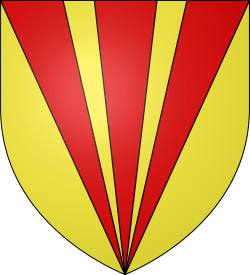David, Lord of Brechin
Sir David de Brechin (died 1320) was a Scottish knight who fought on both sides during the Wars of Scottish Independence.

Life
He was the son of Sir William de Brechin by Elena Comyn, daughter of Alexander Comyn, Earl of Buchan and Elizabeth de Quincy. Sir William was the son of Henry, an illegitimate son of David of Scotland, Earl of Huntingdon.[1] Brechin is first attested to as a ward of a Sir John de Callendar in 1292.[2]
Brechin fought in the Earl of Surrey's army at the Battle of Dunbar, and was granted lands previously owned by Alan Durward.[3]
He name appears twice on the 1296 Ragman Rolls for Forfarshire.[4]
In the train of Robert the Bruce, he was present at Peebles when the Bruce, John Comyn, and William Lamberton were sworn in as Guardians of Scotland. Brechin returned to Galloway with Bruce.[5]
By 1301, Sir David was still active in southwestern Scotland. On 8 September Brechin was in a force led by Sir John de Soulis and Sir Ingram de Umfraville, that attacked Lochmaben Castle, and was wounded in the fight.[6]
Brechin returned to English service when he did homage to Edward I of England at the Siege of Stirling Castle.[7]
Continuing in English service, Brechin was present at the Battle of Inverurie, and according to John Barbour, he retired after the battle to Brechin Castle where he was besieged by David Earl of Atholl.[8] However this is contested by the historian and genealogist Sir James Balfour Paul.[9] According to all records, Strathbogie was still in the service of the English, so the capture of Brechin Castle must have been accomplished by another of King Robert's following.[10]
On 6 April 1320, Brechin appended his seal to the Declaration of Arbroath.
At a parliament at Scone (later known as the Black Parliament) in August that year, Brechin was found complicit along with William de Soules, the Countess of Strathearn and others in a conspiracy to depose the king. For this offence Brechin was executed.[11]
Although he may very well have been guilty, his execution surprised some people, as he was seen as a "flower of chivalry", having acquitted himself well in battle against the Saracens in the past.
Marriages and issue
Brechin appears to have married Margaret de Bonkyll, widow of Sir John Stewart of Bonkyll, by 1304 when she is recorded as his wife.[12] and had issue.
- Margaret de Brechin, married in 1315 to Sir David de Barclay
David de Brechin appears to have married secondly a Margaret Ramsay.
References
Notes
- A. A. M. Duncan, Brechin, Sir David (b. before 1278, d. 1320), in Oxford Dictionary of National Biography, Oxford University Press, 2004, accessed 18 Dec 2011
- Balfour Paul, vol ii, p 218
- Balfour Paul, vol ii, p 218
- Cal. Doc. Scot. vol. ii, pp 199,209
- Cal. Doc. Scot. vol ii, p 525
- Stevenson vol ii, p 432
- Cal. Doc. Scot. vol ii, p 410
- Brus, pp 198-203
- Balfour Paul, voll ii, p 219 notes
- Barron, Evan Mcleod (1987). The Scottish War of Independence (Second ed.). Barnes & Noble. p. 307.
- Fordun, p 341
- Cal. Doc. Scot. vol ii, pp410-411
Sources
- Calendar of documents relating to Scotland preserved in Her Majesty's Public Record Office. V vols., ed Bain. London 1881.
- Balfour Paul, Sir James-The Scots Peerage-IX Vols. Edinburgh 1904.
- Stevenson, Rev. Joseph, Documents illustrative of the History of Scotland II vols. Edinburgh 1870.
- Traquair, Peter Freedom's Sword